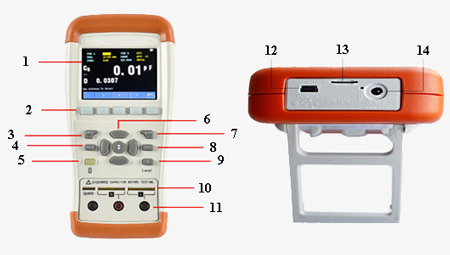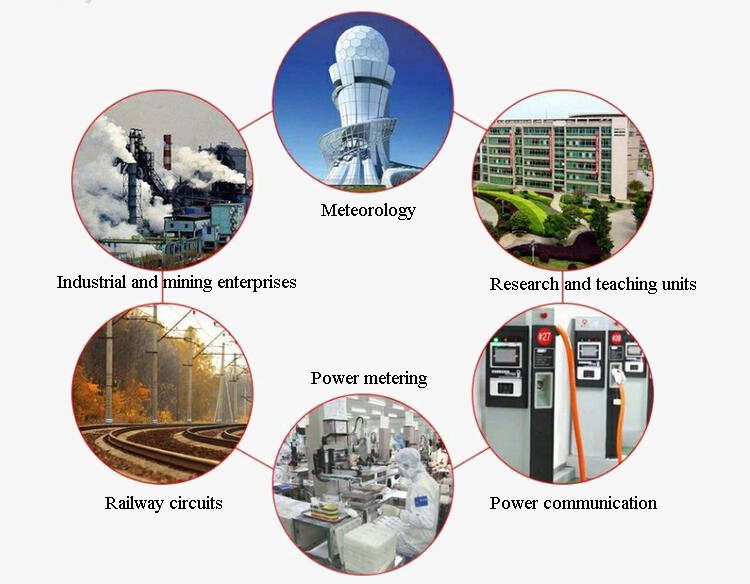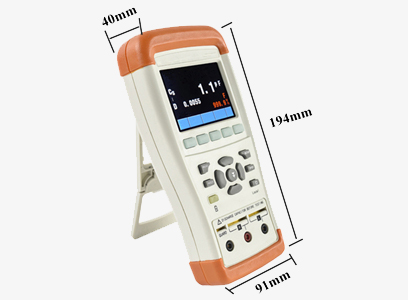sisco portable LCR meter can measure inductance (L) max. 9999H, capacitance (C) max. 9999μF, resistance (R) max. 99.99MΩ. This LCR tester with LCD display and USB communication function, can be used for electronic instrument maintenance and research technology engineering.
Features
- 2.8-inch true color LCD display with high brightness.
- USB communication function, built-in Mini-USB interface (virtual serial port). Comparison function of a set of recorded main specifications.
- Switchable attachment (AUX) sequencing correction function: open and short circuit scan frequency removal in full range.
- 7.4V, 1300mAh charging interface serial port for rechargeable lithium batteries.

Handheld LCR meter panel details
- TFT-LCD display
- Function Key
- Meas function key
- Data hold key
- Power switch
- Cursor key
- Setup key
- System key
- Backlight adjusting key
- Terminal test socket
- Terminal test socket
- Remote control interface
- SD card socket
- Adapter socket
Applications
Handheld LCR meter is widely used in the fields of electric power, petrochemical industry, metallurgy, railway, meteorology, industrial and mining enterprises, metrology departments, scientific research institutions and so on.

| Model | SISCO-LCRM-825 | SICO-LCRM-826 |
| Test Specifications | L, C, R, Z | |
| Monitoring Specifications | D, Q, θ (deg), θ (rad) ESR | |
| Accuracy | 0.20% | |
|
Frequency
|
100Hz, 120Hz, 1kHz, 10kHz, 100kHz | 100Hz, 120Hz, 1kHz, 10kHz |
|
Display Range
|
L: 0.01μH~9999H Q: 0.0001~9999 C: 0.01pF~9999μF θ (deg): -179.99°~179.99° R, Z: 0.0001Ω~99.99MΩ θ (rad): -3.1416~3.1416 D: 0.001~9.999 |
L: 0.01μH~9999H Q: 0.0001~9999 C: 0.01pF~9999μF θ (deg): -179.99°~179.99° R, Z: 0.0001Ω~99.99MΩ θ (rad): -3.1416~3.1416 D: 0.001~9.999 |
|
Source Resistance
|
100Ω | |
| Range | Automatic or Manual | |
| Maximum Reading | 5 bits of main specification and 5 bit display of sub specification | |
| Signal Level | 0.6Vrms | |
| Test Speed | 4 times/second, 1.5 times/second | |
| Comparator | 1 sets, compare main specifications | |
| Adjustment | Open/short scan frequency reset for each range | |
| Interface | Build-in Mini-USB interface (virtual interface) Charging interface |
|
| Others | 2.8 inch real color 16M color TFT-LCD display, touch screen, data retention function, USB communication, compatible SCPI instruction set, middle and English switching, backlight adjustment, automatic shutdown | |
| Power Requirements | Input: 100~240V, 50/60Hz, 0.35A Output: 9V 1A DC 7.4V Li, 1300mAh Rechargeable battery |
|
| Certification | CE | |
| Size (mm) | 91 (W) x 194 (H) x 40 (D) | |
Dimension

Q1: What is a LCR meter?
A1: LCR meter is also called LCR bridge or LCR tester. It can accurately and stably measure various component specifications, is a tester mainly used to test inductance (L), capacitance (C), and resistance (R). Digital LCR meter has two detection modes: series mode and parallel mode. The series mode is based on detection for component impedance Z, and the parallel mode is based on detection for component admittance Y. Digital LCR meter has the features of direct function and easy operation. It can meet test requirements of devices in production line quality assurance, incoming inspection, electronic repair and other industries with a lower budget.
Q2: What are the functions of LCR meter?
A2: The LCR tester is mainly used to measure the impedance of various electronic products, and can also measure the transmission performance of electronic components. In the actual measurement, there are many standard interfaces on the LCR tester, and the corresponding standard interface can be selected according to the situation of the electronic components to be measured, and the measurement can be performed automatically. The response time of this measurement is very fast, and the error is very small. The error of the current LCR tester can be less than 0.1%.
Q3: How does a LCR meter work?
A3: The measurement object of the digital LCR tester is the parameters of the impedance element, including the AC resistance R, the inductance L and its quality factor Q, the capacitance C and its loss factor D. Therefore, the digital LCR tester is often referred to as a digital LCR measuring instrument.
It is measured at frequencies from the power frequency to about 100 kHz. The basic measurement error is 0.02%, generally around 0.1%. Its impedance is represented by Zx, and Rr is a standard resistor. The switch can measure the voltages Ux and Ur respectively, so there is the following formula: Zx = Ux/Ix = Rr * Ux/Ur
This formula is a phasor relational formula. For example, the phase sensitive detector (PSD) is used to measure the in-phase component and quadrature component of Ux and Ur corresponding to a certain reference phasor, and then the analog-to-digital converter (A/D) converts them into digital quantities, and then The complex number operation is carried out by the computer, and the resistance value and reactance value that make up the measured impedance Zx can be obtained.
Tips: How to replace the battery of the handheld LCR meter?
- Use a Phillips screwdriver to remove the screws on the bottom case of the handheld LCR meter to open the bottom case.
- Remove the battery from the battery bay under the motherboard to replace it.
- The battery must be a standard model rechargeable lithium battery.
- Cover the bottom case and tighten it, the replacement is complete.
Note: If the portable LCR meter is not used for more than 3 months, or the external power adapter has been used for operation, please remove the battery to prevent the battery from leaking out of the corroded circuit board and damaging the digital LCR meter.
Thank you for buying industrial test and measurement equipment on SISCO.com, all products sold by SISCO and the partner cover a 12 months warranty, effective from the date of receiving the products.
What is covered?
SISCO is responsible for providing free spare parts, and free technical support to assist the customer to repair the defective products until the problem is solved.
What is not covered?
- Product purchased from anyone other than a SISCO store or a SISCO authorized reseller.
- Expendable parts.
- Routine cleaning or normal cosmetic and mechanical wear.
- Damage from misuse, abuse or neglect.
- Damage from use of parts other than SISCO approved.
- Damage from use outside the product’s usage or storage parameters.
- Damage from use of parts not sold by SISCO.
- Damage from modification or incorporation into other products.
- Damage from repair or replacement of warranted parts by a service provider other than a SISCO authorized service provider.
- Damage caused by the application environment not meeting the product usage requirements and the failure to perform preventive maintenance.

